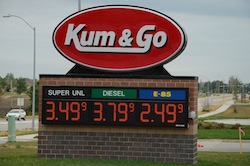A bottleneck of too few fuel stations that offer E85 (85% ethanol 15% gasoline), along with price incongruity are two major factors that reduce the ability of E85 to help meet increasing Renewable Fuel Standard (RFS) biofuel mandates. Iowa State University economists Bruce A Babcock and Sebastien Pouliot state in “How Much E85 Can Be Consumed in the U.S.” that flex fuel vehicles (FFVs) on the road are sufficient in number to consume 3 billion gallons of ethanol if E85 was priced at parity with E10 (estimates for 2014 are 16 million FFVS on the road in the U.S.).
Today, nearly every gallon of gasoline sold in the U.S. already contains a 10 percent ethanol blend. When looking at the RFS goals of 36 billion gallons of biofuels by 2022, this means that in order to achieve the goals, higher blends of ethanol will be required to be sold. Only FFVs can use ethanol blends above E15 and only vehicles manufactured in 2001 or newer can use E15.
 The dichotomy lies in the fact that while 7 percent of vehicles on the roads are FFVs and growing, only 2 percent of the approximately 121,446 fuel stations in the country offer higher blends of ethanol. In addition, the distribution of flex fuel vehicles does not correspond well with the location of the E85 stations. For example, Texas, California and Florida are several examples of high FFV concentration versus low E85 availability. This results in a loss of potential market.
The dichotomy lies in the fact that while 7 percent of vehicles on the roads are FFVs and growing, only 2 percent of the approximately 121,446 fuel stations in the country offer higher blends of ethanol. In addition, the distribution of flex fuel vehicles does not correspond well with the location of the E85 stations. For example, Texas, California and Florida are several examples of high FFV concentration versus low E85 availability. This results in a loss of potential market.
One other barrier to adoption, according to the paper, was that historically, E85 was priced at a level that increased drivers’ fuel costs versus conventional fuel blends due to the fuel economy loss (studies range from 15 percent to 40 percent depending on type of vehicle, driving habits, etc.) disinclining FFV owners to purchase the fuel. However, this trend is changing due to better pricing of E85 at the pump.
The authors note that while the RFS mandates renewable fuel volumes in excess of 10 percent and flex fuel vehicles and higher ethanol blends exist that would help achieve that mandate, market conditions have not been adjusted to take advantage.
“The dilemma we attempt to answer is how much E85 would be consumed if consumers had unhindered access to the E85 fuel and it was priced competitively with other fuel choices,” said Bruce Babcock, co-author of the study. “When priced at parity under these conditions, with no change to fleet size, consumption of E85 could increase to 3 billion gallons. Introducing E85 pumps in areas with large flex vehicle fleets such as Texas would also increase consumption.”
The paper also details how higher Renewable Identification Numbers (RINS), the currency per se, of ethanol credits that obligated parties such as oil companies accumulate to show compliance with the RFS, also create incentives to price E85 more competitively. This would also result in higher use of ethanol blends.
The paper and its two companion pieces, “RFS Compliance: Death Spiral Or Investment In E85?” and “The Economic Role of RIN Prices” assess the complicated path that the liquid fuel industry must take to meet the federal mandate for renewable fuel volumes.

